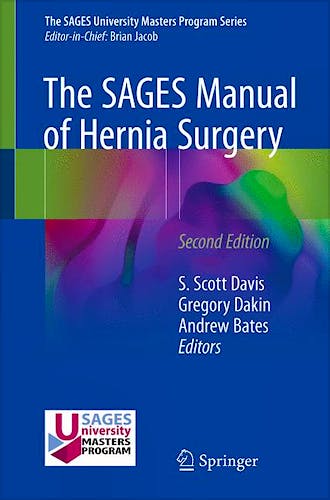

There are no products in the cart.



The SAGES Manual of Hernia Surgery
Davis, S. — Dakin, G. — Bates, A.
2ª Edition January 2019
English
ISBN 9783319784113
Publisher SPRINGER
Printed Book
-5%
103,99 €98,79 €VAT included
99,99 €94,99 €VAT not included
Receive it within
2 - 3 weeks
Electronic Book
-5%
93,59 €88,91 €VAT included
89,99 €85,49 €VAT not included
OnLine Access
Immediate
This eBook uses the Bookshelf platform.
What is Bookshelf?
Bookshelf is a tool for managing your eBooks. With online access, you will have a library with all your eBooks. To learn more about Bookshelf, watch an explanatory video .
The eBooks you purchase can be used directly in the browser through the web application Bookshelf Online You can also download them to a Native App to read them anytime and on any device, even when you don't have internet access.
The purchase includes 1 year of Bookshelf Online. The downloaded copy on your device does not expire.
Native Applications
For computers with the following systems:
For mobile devices:
Functionality
The Bookshelf apps offer functionality that goes beyond what printed books provide:
- Online and offline access on mobile or desktop devices
- Bookmarks, highlights, and notes synchronized across all your devices
- Study tools like shared notes and integration with Microsoft OneNote
- Search and navigation of content across your entire Library
- Interactive notebook and text-to-speech functionality
- Online search for additional information by highlighting a word or phrase
SAGES University MASTERS PROGRAM: Hernia Pathway. Laparoscopic Ventral Hernia Repair.- Masters Program Hernia Pathway: Laparoscopic Inguinal Hernia.- Hernia Materials-Fundamentals of Prosthetic Characteristics.- Permanent Prosthetics: Polypropylene, Polyester, ePTFE, Hybrid Mesh.- Biologic and Absorbable Prosthetic: When, Why, and Where are we Going.- Prosthetic Fixation Options.- How to Choose a Mesh in Hernia Repair.- Patient Comorbidities Complicating a Hernia Repair: The Preoperative Workup and Postoperative Planning.- Enhanced Recovery in Abdominal Hernia Repair.- Computed Tomography and Gross Anatomy of the Abdominal Wall (Including Planes for Mesh Hernia Repair).- Umbilical Hernia Options.- Bridging Versus Closing the Defect during MIS Ventral Hernia Repair: Pros and Cons.- Robotic Technique for Intraperitoneal Onlay Mesh (IPOM).- Ventral, Incisional and Atypical Hernias Using a Robotic Transabdominal Preperitoneal Approach.- Technique: Posterior Rectus Sheath.- Ventral Abdominal Hernia Repair Technique: External Oblique Release.- Techniques: Transversus Abdominis Release.- Robotic Transveruss Abdominis Release: Tips and Tricks.- Ventral Abdominal Hernia Repair: MIS Extraperitoneal Repaie Techniques: eTEP Rives, MILOS/EMILOS and Onlay MIS Repair.- Component Separations: Outcomes and Complications.- Botulinum Toxin in Abdominal Wall Hernia Repair.- Mesh Sutured Repairs of the Abdominal Wall.- Treatment of Parastomal Hernias.- Challenging Hernias: Spigelian, Flank Hernias, Suprapubic, and Subxiphoid.- Recurrent Ventral Hernia Repair.- Loss of Abdominal Domain.- Fixation vs. Fixation in MIS Inguinal Hernia Repair.- Open Techniques: Mesh and Non-Mesh Anatomical Repairs.- MIS Techniques: Lap TAPP and rTAPP.- MIS vs Open Inguinal Hernia for Uncomplicated Unilateral Hernia.- TAPP vs. TEP vs. rTAPP: What does the Evidence Show?.- Minimally Invasive Surgical Techniques for Inguinal Hernia Repair: The Extended-View Totally Extraperitoneal Approach (eTEP).- Inguinal Hernia Repair with Mini-laparoscopic Instruments.- The Cavernous Direct Inguinal Hernia.- Remoral Hernia and Other Hidden Hernias: Options and Strategies.- Strangulated Inguinal Hernia: Options and Strategies.- Groin Pain Syndromes in Athletes: Sports Hernia.- Chronic Pain After Inguinal Repair.- Intraoperative and Postoperative Complications of MIS Inguinal Hernia Repair.- Repair of Paraesophageal Hernia.- Repair of Congenital Diaphragm Hernias: Morgagni and Bochdalek.- Revisional Paraesophaeal Hernia: Tips and Tricks.- Establishing a Hernia Program.- Prevention of Abdominal Wall Hernias.- Hernias in the Pediatric Population.- Herniorrhaphy in Cirrhosis: Operative Approach and Timing.- Concurrent Hernia Repair with Gynecologic or Urologic Surgery: Pros and Cons.
This edition of the SAGES Manual of Hernia Surgery aligns with the current version of the new SAGES University MASTERS Program Hernia Surgery pathway. This manual serves as a curriculum for participants in the MASTERS Program as well as a modern text on hernia surgery for all learners. Hernia surgery is one of the fastest developing fields in General Surgery today. There have been rapid advancements in hernia techniques in recent years which make most prior texts on the subject obsolete. These advancements involve significant evolution in both the techniques and strategies for hernia repairs, as well as the tools used to achieve these means. This text thoroughly addresses the multiple component separation techniques and options for locations of mesh repairs. It also discusses the revolution of hernia repair being facilitated by robotic surgery, which allows increased access to minimally invasive techniques for surgeons and thus increased access to minimally invasive surgical repairs for patients. This manual will be a valuable resource for interested surgeons to understand the variety of potential approaches to individual hernias and to individually tailor the care of the hernia patient.
S. Scott Davis, Jr., MD, FACS
Associate Professor of Surgery
Department of Surgery
Emory University
Atlanta, GA
Gregory F. Dakin, MD, FACS
Associate Professor of Surgery
Weill Cornell Medical College
New York, NY 10065
Andrew Bates, MD
Assistant Professor of Surgery
Stony Brook University Hospital
Stony Brook, NY
© 2025 Axón Librería S.L.
2.149.0